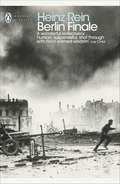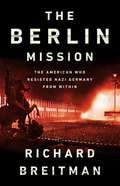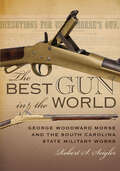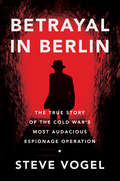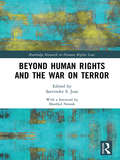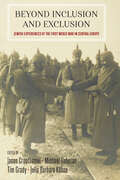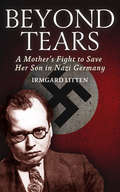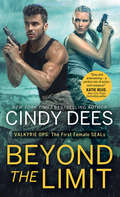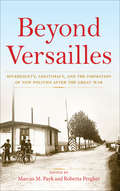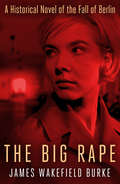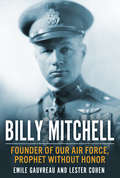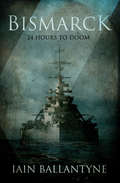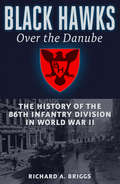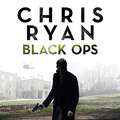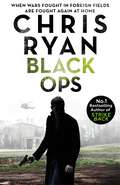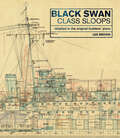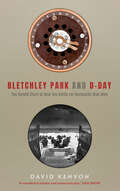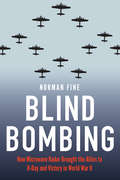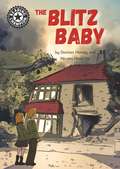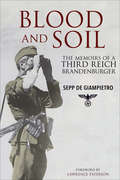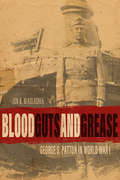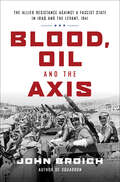- Table View
- List View
Berlin Finale (Penguin Modern Classics)
by Heinz ReinOne of the first bestsellers in Germany after the Second World War, Berlin Finale is a breathtaking novel of resistance set against the downfall of the Third ReichApril 1945, the last days of the Nazi regime. While bombs are falling on Berlin, the Gestapo still search for traitors, resistance fighters and deserters. People mistrust each other more than ever. In the midst of chaos, a disparate group - a disillusioned young soldier; a trade unionist and saboteur; a doctor helping refugees - continues to fight back. And in Oskar Klose's pub, the resistance plan their next move, hunted at every step by the SS. Published in the immediate aftermath of the Second World War, Berlin Finale is an unforgettable portrait of life in a city devastated by war.Translated by Shaun Whiteside
The Berlin Mission: The American Who Resisted Nazi Germany from Within
by Richard BreitmanAn unknown story of an unlikely hero--the US consul who best analyzed the threat posed by Nazi Germany and predicted the horrors to comeIn 1929, Raymond Geist went to Berlin as a consul and handled visas for emigrants to the US. Just before Hitler came to power, Geist expedited the exit of Albert Einstein. Once the Nazis began to oppress Jews and others, Geist's role became vitally important. It was Geist who extricated Sigmund Freud from Vienna and Geist who understood the scale and urgency of the humanitarian crisis.Even while hiding his own homosexual relationship with a German, Geist fearlessly challenged the Nazi police state whenever it abused Americans in Germany or threatened US interests. He made greater use of a restrictive US immigration quota and secured exit visas for hundreds of unaccompanied children. All the while, he maintained a working relationship with high Nazi officials such as Heinrich Himmler, Reinhard Heydrich, and Hermann Göring.While US ambassadors and consuls general cycled in and out, the indispensable Geist remained in Berlin for a decade. An invaluable analyst and problem solver, he was the first American official to warn explicitly that what lay ahead for Germany's Jews was what would become known as the Holocaust.
The Best Gun in the World: George Woodward Morse and the South Carolina State Military Works
by Robert S. SeiglerA thoroughly researched account of weapons innovation and industrialization in South Carolina during the Civil War and the man who made it happen.A year after seceding from the Union, South Carolina and the Confederate States government faced the daunting challenge of equipping soldiers with weapons, ammunition, and other military implements during the American Civil War. In The Best Gun in the World, Robert S. Seigler explains how South Carolina created its own armory and then enlisted the help of a weapons technology inventor to meet the demand. Seigler mined state and federal factory records, national and state archives, and US patents for detailed information on weapons production, the salaries and status of free and enslaved employees, and other financial records to reveal an interesting, distinctive story of technological innovation and industrialization in South Carolina.George Woodward Morse, originally from New Hampshire, was a machinist and firearms innovator, who settled in Louisiana in the 1840s. He invented a reliable breechloading firearm in the mid-1850s to replace muzzleloaders that were ubiquitous throughout the world. Essential to the successful operation of any breechloader was its ammunition, and Morse perfected the first metallic, center-fire, pre-primed cartridge, his most notable contribution to the development of modern firearms.The US War Department tested Morse rifles and cartridges prior to the beginning of the Civil War and contracted with the inventor to produce the weapons at Harpers Ferry Armory. However, when the war began, Morse, a slave-holding plantation owner, determined that he could sell more of his guns in the South. The South Carolina State Military Works originally designed to cast cannon, produced Morse’s carbine and modified muskets, brass cartridges, cartridge boxes, and other military accoutrements. The armory ultimately produced only about 1,350 Morse firearms. For the next twenty years, Morse sought to regain his legacy as the inventor of the center-fire brass cartridges that are today standard ammunition for military and sporting firearms.“Does justice to one of the greatest stories in American firearms history. If George Woodward Morse had not sided with the Confederacy, his name might be as famous today as Colt or Winchester.” —Gordon L. Jones, Atlanta History Center “Excellent and well-researched.” —Patrick McCawley, South Carolina Department of Archives and History“For connoisseurs and scholars of military history (especially Civil War), history of technology, or Southern/South Carolina history, this is a must-read and reference volume pertaining to a previously little-known aspect of the nineteenth century that had a far-reaching impact in the manner wars would be fought by soldiers decades later.” —Barry L. Stiefel, College of Charleston
Betrayal in Berlin: The True Story of the Cold War's Most Audacious Espionage Operation
by Steve VogelThe astonishing true story of the Berlin Tunnel, one of the West’s greatest espionage operations of the Cold War—and the dangerous Soviet mole who betrayed it.Its code name was “Operation Gold,” a wildly audacious CIA plan to construct a clandestine tunnel into East Berlin to tap into critical KGB and Soviet military telecommunication lines. The tunnel, crossing the border between the American and Soviet sectors, would have to be 1,500 feet (the length of the Empire State Building) with state-of-the-art equipment, built and operated literally under the feet of their Cold War adversaries. Success would provide the CIA and the British Secret Intelligence Service access to a vast treasure of intelligence. Exposure might spark a dangerous confrontation with the Soviets. Yet as the Allies were burrowing into the German soil, a traitor, code-named Agent Diamond by his Soviet handlers, was burrowing into the operation itself. . . Betrayal in Berlin is Steve Vogel’s heart pounding account of the operation. He vividly recreates post-war Berlin, a scarred, shadowy snake pit with thousands of spies and innumerable cover stories. It is also the most vivid account of George Blake, perhaps the most damaging mole of the Cold War. Drawing upon years of archival research, secret documents, and rare interviews with Blake himself, Vogel has crafted a true-life spy story as thrilling as the novels of John le Carré and Len Deighton.Betrayal in Berlin includes 24 photos and two maps.
Beyond Human Rights and the War on Terror (Routledge Research in Human Rights Law)
by Satvinder S. JussThis edited collection provides a comprehensive, insightful, and detailed study of a vital area of public policy debate as it is currently occurring in countries across the world from India to South Africa and the United Kingdom to Australia. Bringing together academics and experts from a variety of jurisdictions, it reflects upon the impact on human rights of the application of more than a decade of the "War on Terror" as enunciated soon after 9/11. The volume identifies and critically examines the principal and enduring resonances of the concept of the "War on Terror". The examination covers not only the obvious impacts but also the more insidious and enduring changes within domestic laws. The rationale for this collection is therefore not just to plot how the "War on Terror" has operated within the folds of the cloak of liberal democracy, but how they render that cloak ragged, especially in the sight of those sections of society who pay the heaviest price in terms of their human rights. This book engages with the public policy strand of the last decade that has arguably most shaped perceptions of human rights and engendered debates about their worth and meaning. It will be of interest to researchers, academics, practitioners, and students in the fields of human rights law, criminal justice, criminology, politics, and international studies.
Beyond Inclusion and Exclusion: Jewish Experiences of the First World War in Central Europe
by Jason Crouthamel Tim Grady Michael Geheran Julia Barbara KöhneDuring the First World War, the Jewish population of Central Europe was politically, socially, and experientially diverse, to an extent that resists containment within a simple historical narrative. While antisemitism and Jewish disillusionment have dominated many previous studies of the topic, this collection aims to recapture the multifariousness of Central European Jewish life in the experiences of soldiers and civilians alike during the First World War. Here, scholars from multiple disciplines explore rare sources and employ innovative methods to illuminate four interconnected themes: minorities and the meaning of military service, Jewish-Gentile relations, cultural legacies of the war, and memory politics.
Beyond Tears: A Mother's Fight to Save Her Son in Nazi Germany
by Irmgard LittenBeyond Tears: A Mother's Fight to Save Her Son in Nazi Germany, first published in 1940, is the heart-wrenching story of Irmgard Litten about her son, Hans, an anti-Nazi lawyer who was arrested in 1933 (and never charged or tried in court). Hans spent the next 5 years in prisons and concentration camps, undergoing numerous interrogation and torture sessions at the hands of his captors, before finally committing suicide. He was 34 at the time of his death. His mother made an untiring effort to learn of her son's condition and to secure his release but to no avail. She recounts her journey in Beyond Tears, which remains an incredibly moving, heroic story.Of historical interest is that Hans Litten represented opponents of the Nazis at political trials between 1929 and 1932. During one trial in 1931, Litten subpoenaed Adolf Hitler to appear as a witness; Litten then cross-examined Hitler for three hours. By the end, Hitler was so shaken by the experience that, even years later, he would not allow Litten's name to be mentioned in his presence. In retaliation, Litten was arrested on the night of the Reichstag Fire where he would spend the next 5 years imprisoned until his untimely death at Dachau concentration camp. In 2011 Litten was portrayed in a BBC broadcast titled The Man Who Crossed Hitler, set in Berlin in summer 1931.
Beyond the Limit (Valkyrie Ops #1)
by Cindy DeesTeam Reaper has a new mission...Train the first female SEALsNavy SEAL Griffin Caldwell is not happy with his team's top-secret mission, training the first female SEALs. Griffin's determined to prove that that his trainee Sherri Tate—a former beauty queen no less—doesn't have what it takes to join the world's most elite warrior's club. Until he sees what she's capable of, and even this hard-nosed SEAL has to admit she's tough as nails. What he won't admit to is the attraction sizzling between them.Navy media officer Sherri Tate is more than just a pretty face. When she's given the opportunity to achieve her dream of becoming a SEAL, she won't let anything stand in her way, not even her arrogant trainer, who is too sexy for words. When a dangerous mission lands Sherri and Griffin in the cross hairs of the world's most feared terrorist, it's going to take everything they have to come out with their lives—and hearts—intact.Praise for Cindy Dees:"A pulse-pounding adventure that will keep readers enthralled."—RT Book Reviews for Hot Intent"A well-crafted plot with plenty of action, love and danger...make this a must-read romance."—RT Book Reviews for Undercover with a SEAL
Beyond Versailles: Sovereignty, Legitimacy, and the Formation of New Polities After the Great War
by Edited by Marcus M. Payk and Roberta PergherTen essays analyzing the history and effects of the Paris Peace Conference following World War I. The settlement of Versailles was more than a failed peace. What was debated at the Paris Peace Conference of 1919–1920 hugely influenced how nations and empires, sovereignty, and the international order were understood after the Great War?and into the present. Beyond Versailles argues thatthis transformation of ideas was not the work of the treaty makers alone, but emerged in interaction with nationalist groups, anti-colonial movements, and regional elites who took up the rhetoric of Paris and made it their own. In shifting the spotlight from the palace of Versailles to the peripheries of Europe, Beyond Versailles turns to the treaties&’ resonance on the ground and shows why the principles of the peace settlement meant different things in different locales. It was in places a long way from Paris?in Polish borderlands and in Portuguese colonies, in contested spaces like Silesia, Teschen, and Danzig, and in states emerging from imperial collapse like Austria, Egypt, and Iran?that notions of nation and sovereignty, legitimacy, and citizenship were negotiated and contested.&“This is an excellent collected volume, well-conceived and very well written. . . . This is not at all a top-down history of the diffusion of ideas about national self-determination. Rather, it is an examination of the ways in which these ideas were taken up, re-fashioned, and reasserted at many levels to serve local and regional agendas, while at the same time influencing international debates about the meanings and possible implementations of self-determination.&” —Pieter M. Judson, author of The Habsburg Empire: A New History
The Big Rape
by James Wakefield BurkeThe Big Rape, was first published in 1952 by Esquire's war correspondent James Wakefield Burke (1904-1989). The book, historically accurate in terms of place and events, is a fictional account of a German woman – Lilo Markgraf – in Nazi Germany, and traces the fall of Berlin to the Russians, and the subsequent widespread rape and debauchery the Red Army soldiers inflicted on the populace. At first, Lilo is an ardent nationalist and in love with a German soldier, but following the rape of her mother and her younger sister by Russian soldiers, Lilo returns from a small town to Berlin to attempt her revenge. She later becomes the mistress of a Soviet NKVD officer, taking advantage of the protection and benefits he can provide her. Finally, with the coming of the Americans in their occupied portion of Berlin, she attempts to plan her future.
Billy Mitchell: Founder of our Airforce, Prophet Without Honor
by Emile Gauvreau Lester CohenBilly Mitchell: Founder of Our Air Force and Prophet without Honor, first published in 1942, is a look at the life and controversial career of William “Billy” Mitchell (1879-1936), considered the father of the U.S. Air Force. The book's focus is on Mitchell's campaign for increased spending for building new and improved aircraft and his vision of the role aircraft would play in any future wars, especially against naval ships. Mitchell's outspokenness led to his court-martial for insubordination in 1925.
Bismarck: 24 Hours to Doom
by Iain BallantyneWith extensive eyewitness accounts, the author of Killing the Bismarck vividly reconstructs the day British soldiers sank the infamous Nazi battleship. May 26, 1941. After a desperate chase lasting three days and more than seventeen hundred miles, Britain’s Home Fleet would finally close in on the world’s most powerful battleship, the very ship that sank the Royal Navy’s battlecruiser HMS Hood. The German battleship Bismarck was literally in a class by itself, being one of two newly-designed Bismarck-class ships in the German fleet. But it would soon face, and ultimately lose, a brutal fight to the finish involving more than five thousand men of the Royal Navy and twenty-six thousand men of Hitler’s Kriegsmarine. Historian Iain Ballantyne spent years conducting interviews with surviving veterans who had been present on that fateful day. Published here for the first time, alongside a compelling narrative of the final twenty-four hours of the mission to sink the Bismarck, are transcripts of those interviews, offering the unique eyewitness accounts of Royal Navy sailors who participated in one of the most significant sea battles of World War II.
Black Hawks over the Danube
by Richard A. BriggsBlack Hawks Across the Danube, first published in 1954, is an account, based on the author's service in the Division and official Army records, of the formation and deployment of the 86th Infantry Division during World War II. The 86th Division, known as the Black Hawks, was notable for a number of reasons: 1. The 86th Division was the first allied division to cross the Danube River; 2. The 86th Division captured some 53,354 German soldiers; 3. The Black Hawks conquered over 220 miles of enemy territory in the Ruhr Pocket and in Bavaria and Austria; 4. The division liberated over 200,000 allied prisoners of war, including over 110,000 in one camp near Moosburg; 5. The Black Hawks made several important river crossings, with amphibious assaults of the Danube, Bigge, Altmühl, Isar, Mittel-Isar, Inn, and Salzach; 6. The Division Served in actual combat with four different American armies (the only Division to set this record on the western front); 7. Later the Black Hawks became the first division to serve in both the European and Pacific theaters of operation (only one other division actually served in the Pacific after European duty). Author Richard Briggs was an infantryman in the 86th Division for over two years, including its service in the Philippines following the European campaign. Included are 15 pages of maps and photographs.
Black Ops: Danny Black Thriller 7 (Danny Black #7)
by Chris RyanThe seventh book in the bestselling Danny Black series.A series of gruesome killings take place in Dubai, Ghana and America. The victims are all connected with the SAS. In Hereford Danny Black realises they have something more specific in common - they were all involved in training a young Muslim soldier, Ibrahim Khan.Khan has been working under cover in Islamic State in a mission organised by MI6. Danny Black sets out to track him down with the help of Khan's MI6 handler on a trail that leads him to a library of ancient manuscripts in Damascus, the Syrian desert and finally back in the Brecon Beacons. There Danny discovers that he has finally met his match, his deadliest enemy - and it is the last person he ever expected.(P)2019 Hodder & Stoughton Limited
Black Ops: Danny Black Thriller 7 (Danny Black #7)
by Chris RyanThe seventh book in the bestselling Danny Black series.A series of gruesome killings take place in Dubai, Ghana and America. The victims are all connected with the SAS. In Hereford Danny Black realises they have something more specific in common - they were all involved in training a young Muslim soldier, Ibrahim Khan.Khan has been working under cover in Islamic State in a mission organised by MI6. Danny Black sets out to track him down with the help of Khan's MI6 handler on a trail that leads him to a library of ancient manuscripts in Damascus, the Syrian desert and finally back in the Brecon Beacons. There Danny discovers that he has finally met his match, his deadliest enemy - and it is the last person he ever expected.(P)2019 Hodder & Stoughton Limited
Black Ops: Danny Black Thriller 7 (Danny Black #7)
by Chris RyanThe seventh book in the bestselling Danny Black series.A series of gruesome killings take place in Dubai, Ghana and America. The victims are all connected with the SAS. In Hereford Danny Black realises they have something more specific in common - they were all involved in training a young Muslim soldier, Ibrahim Khan.Khan has been working under cover in Islamic State in a mission organised by MI6. Danny Black sets out to track him down with the help of Khan's MI6 handler on a trail that leads him to a library of ancient manuscripts in Damascus, the Syrian desert and finally back in the Brecon Beacons. There Danny discovers that he has finally met his match, his deadliest enemy - and it is the last person he ever expected.(P)2019 Hodder & Stoughton Limited
Black Swan Class Sloops: Detailed in the Original Builders' Plans
by Les BrownAn illustrated reference featuring the superbly drawn plans for these highly effective anti-submarine ships. The technical details of British warships were recorded in a set of plans produced by the builders on completion of every ship. Known as the &“as fitted&” general arrangements, these drawings represented the exact appearance and fitting of the ship as it entered service. Intended to provide a permanent reference for the Admiralty and the dockyards, these plans were drawn with exquisite skill in multi-colored inks and washes that represent the acme of the draftsman&’s art. Today they form part of the collection of the National Maritime Museum at Greenwich, which is using the latest scanning technology to make digital copies of the highest quality. This book is one of a series based entirely on these drafts, depicting famous warships in unprecedented detail—complete sets in full color, with many close-ups and enlargements that make every aspect clear. Captions point the reader to important features, and an introduction covers the background to the design. This volume is devoted to the sloops of the Black Swan class and its improved derivatives, widely regarded as the &“Rolls-Royce&” of Second World War convoy escorts. Heavily armed and superbly equipped for their role, they were among the most effective anti-submarine ships of the battle in the Atlantic. The design was gradually improved and this book uses plans of four selected ships to chart that development. These comprise: Black Swan as built; Flamingo as modified later; Starling, the single most successful U-boat hunter of the war, as in 1943; and Amethyst, as refitted after her clash with Chinese communists on the Yangtze in 1949.
Bletchley Park and D-Day: The Untold Story of How the Battle of Normandy Was Won
by David KenyonThe untold story of Bletchley Park's key role in the success of the Normandy campaign Since the secret of Bletchley Park was revealed in the 1970s, the work of its codebreakers has become one of the most famous stories of the Second World War. But cracking the Nazis’ codes was only the start of the process. Thousands of secret intelligence workers were then involved in making crucial information available to the Allied leaders and commanders who desperately needed it. Using previously classified documents, David Kenyon casts the work of Bletchley Park in a new light, as not just a codebreaking establishment, but as a fully developed intelligence agency. He shows how preparations for the war’s turning point—the Normandy Landings in 1944—had started at Bletchley years earlier, in 1942, with the careful collation of information extracted from enemy signals traffic. This account reveals the true character of Bletchley's vital contribution to success in Normandy, and ultimately, Allied victory.
Blind Bombing: How Microwave Radar Brought the Allies to D-Day and Victory in World War II
by Norman FineLate in 1939 Nazi Germany was poised to overrun Europe and extend Adolf Hitler&’s fascist control. At the same time, however, two British physicists invented the resonant cavity magnetron. About the size of a hockey puck, it unlocked the enormous potential of radar exclusively for the Allies. Since the discovery of radar early in the twentieth century, development across most of the world had progressed only incrementally. Germany and Japan had radar as well, but in just three years, the Allies&’ new radar, incorporating the top-secret cavity magnetron, turned the tide of war from doubtful to a known conclusion before the enemy even figured out how. The tactical difference between the enemy&’s primitive radar and the Allies&’ new radar was similar to that between a musket and a rifle. The cavity magnetron proved to be the single most influential new invention contributing to winning the war in Europe. Norman Fine tells the relatively unknown story of radar&’s transformation from a technical curiosity to a previously unimaginable offensive weapon. We meet scientists and warriors critical to the story of radar and its pressure-filled development and implementation. Blind Bombing brings to light two characters who played an integral role in the story as it unfolded: one, a brilliant and opinionated scientist, the other, an easygoing twenty-one-year-old caught up in the peacetime draft. This unlikely pair and a handful of their cohorts pioneered a revolution in warfare. They formulated new offensive tactics by trying, failing, and persevering, ultimately overcoming the naysayers and obstructionists on their own side and finally the enemy.
The Blitz Baby: Independent Reading 15 (Reading Champion #313)
by Damian HarveyDuring a bombing of Plymouth in World War 2, a German plane is shot down near Jenny and Thomas's house. They long to investigate, but they hear something and decide to investigate first. They are soon in grave danger, needing help from the last source they would expect.This first colour chapter book is a perfectly levelled, accessible text for Key stage 2 readers aged 9-10. Reading Champion offers independent reading books for children to practise and reinforce their developing reading skills.Fantastic, original stories are accompanied by engaging artwork and activities to provoke deeper response and encourage writing. Each book has been carefully graded so that it can be matched to a child's reading ability, encouraging reading for pleasure.The Key Stage 2 Reading Champion Books are suggested for use as follows:Independent Reading 11: start of Year 3 or age 7+Independent Reading 12: end of Year 3 or age 7+Independent Reading 13: start of Year 4 or age 8+Independent Reading 14: end of Year 4 or age 8+Independent Reading 15: start of Year 5 or age 9+Independent Reading 16: end of Year 5 or age 9+Independent Reading 17: start of Year 6 or age 10+Independent Reading 18: end of Year 6 or age 10+
Blood and Soil: The Memoir of A Third Reich Brandenburger
by Sepp de GiampietroAvailable for the first time in English, a memoir of a member of the World War II Brandenburg German special forces unit. The Brandenburgers were Hitler&’s Special Forces, a band of mainly foreign German nationals who used disguise and fluency in other languages to complete daring missions into enemy territory. Overshadowed by stories of their Allied equivalents, their history has largely been ignored, making this memoir all the more extraordinary. First published in German in 1984, de Giampietro's highly-personal and eloquent memoir is a vivid account of his experiences. He delves into the reality of life in the unit from everyday concerns and politics to training and involvement in Brandenburg missions. He details the often foolhardy missions undertaken under the command of Theodor von Hippel, including the June 1941 seizure of the Duna bridges in Dunaburg and the attempted capture of the bridge at Bataisk where half of his unit was killed. Given the very perilous nature of their missions, very few of these specially-trained soldiers survived World War II. Much knowledge of the unit has been lost forever, making this is a unique insight into a slice of German wartime history. Widely regarded as the predecessor of today&’s special forces units, this fascinating account brings to life the Brandenburger Division and its part in history in vivid and compelling detail.
Blood, Guts, and Grease: George S. Patton in World War I (American Warriors Series)
by Jon B. MikolashekGeorge S. Patton is one of the most controversial, celebrated, and popular military leaders in American history, and his accomplishments and victories have been greatly documented. Yet Patton spent years in the Army before garnering national attention and becoming a highly-regarded and respected military leader. This work explores Patton's beginnings as a driven and intrepid soldier and his battles leading up to the Great War -- military experiences which would be influential in his development as a commander.Drawing upon Patton's papers and archival documents in the National Archives, this is an early-career biography of the eminent military leader. It begins with his exploits as a relatively junior but ambitious Army officer who, due to his family's wealth and influence, was able to join General John J. Pershing's American Expeditionary Force (AEF). This assignment would ultimately change his life in two ways: it would make Pershing the mentor Patton would emulate for the rest of his life, and it would catapult his military career as the first tanker in the US Army.This study follows Patton's trajectory, from the creation of the Tank Corps and the Light Tank School, to Patton's eventual successes and injuries during the Battle of Saint Mihiel, the attack into Pannes, and the Meuse-Argonne Offensive. Revealed is that the experience Patton gained in World War I was seminal in his evolvement as a leader and laid the groundwork for not only his own personal future triumphs but also for the success of the entire United States Army armored forces in World War II.
Blood, Oil and the Axis: The Allied Resistance Against a Fascist State in Iraq and the Levant, 1941
by John BroichSpring 1941 was a high point for the Axis war machine. Western Europe was conquered; southeastern Europe was falling, Great Britain on its heels; and Rommel’s Afrika Korps was freshly arrived to drive on the all-important Suez Canal. In Blood, Oil and the Axis, historian John Broich tells the story of Iraq and the Levant during this most pivotal time of the war. The browbeaten Allied forces had one last remaining hope for turning the war in their favor: the Axis running through its fuel supply. But when the Golden Square—four Iraqi generals allegiant to the Axis cause—staged a coup in Iraq, elevating a pro-German junta and prompting military cooperation between Vichy French–occupied Syria and Lebanon and the Axis, disaster loomed. Blood, Oil and the Axis follows those who participated in the Allies’ frantic, improvised, and unlikely response to this dire threat: Palestinian and Jordanian Arabs, Australians, American and British soldiers, Free French Foreign Legionnaires, and Jewish Palestinians, all who shared a desperate, bloody purpose in quashing the formation of an Axis state in the Middle East. Memorable figures of this makeshift alliance include Jack Hasey, a young American who ran off to fight with the Free French Foreign Legion before his own country entered the war; Freya Stark, a famous travel-writer-turned-government-agent; and even Roald Dahl, a twenty-three-year-old Royal Air Force recruit (and future author of beloved children’s books). Taking the reader on a tour of cities and landscapes grimly familiar to today’s reader—from a bombed-out Fallujah, to Baghdad, to Damascus—Blood, Oil and the Axis is poised to become the definitive chronicle of the Axis’s menacing play for Iraq and the Levant in 1941 and the extraordinary alliance that confronted it.
Bloodchild: The Godblind Trilogy, Book Three (The Godblind Trilogy #3)
by Anna StephensIn this epic grimdark conclusion to the Godblind Trilogy, heroes, armies, and gods both good and evil will battle one last time, with the fate of the world itself at stake. . . . The great city of Rilpor has fallen. Its walls have crumbled under the siege by the savage Mireces; its defenders have scattered, fleeing for their lives; its new rulers plot to revive the evil Red Gods using the city&’s captured, soon-to-be-sacrificed citizens. Now, with the Fox God leading the shattered remnants of the Rilporian defence and the Mireces consolidating their claim on the rest of the country, it&’s up to Crys, Tara, Mace, Dom and the rest to end the Red Gods&’ scourge once and for all. While the Rilporians plan and prepare for one final, cataclysmic battle to defeat their enemies, the Blessed One and the king of the Mireces have plans of their own: dark plans that will see gods resurrected and the annihilation of the Dancer for all time. Key to their plan is Rillirin, King Corvus&’s sister, and the baby—the Bloodchild—she carries. As both sides face their destinies and their gods, only one thing is clear: death waits for them all.
Bluebell's Christmas Magic
by Marie LavalAn army helicopter pilot is staying in a peaceful English village while he recovers from an injury—but his pretty housecleaner has him in a whirl… Cassie Bell is used to mess. Her cleaning business, Bluebell Cleaning, is well known in the English village of Red Moss. But now it&’s almost Christmas—and Cassie has a slightly messier situation to deal with than usual. She&’s been hired to help Stefan Lambert, an injured army helicopter pilot who&’s staying at the local Belthorn Manor while he recovers. Stefan resents Cassie&’s interference and is definitely not looking for Christmas cheer. But Cassie prides herself on sparkling surfaces—so she&’s determined to bring some festive sparkle to Stefan&’s life too…
